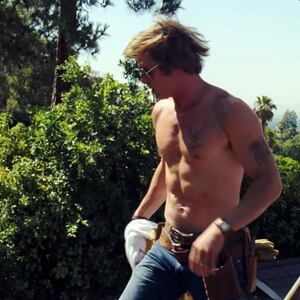When Quentin Tarantino’s ninth and penultimate movie, Once Upon a Time in Hollywood, hit theaters on July 26, the movie internet collectively seized and splintered. The director’s meandering portrait of 1969 Hollywood—half pop-culture archive, part Manson-murder redux, and mostly love letter to Los Angeles—outperformed box office expectations and split critics. Some called it an outmoded monument to male heroism; others praised its attention to the textures and sounds of ‘60s-era excess; more fell in-between. The New Yorker alone published three separate reviews: one calling the film “obscenely regressive,” another exploring its fragile ties to history, and a third unpacking Tarantino’s persistent use of doubles, from stuntmen to lookalikes to the sought-after feeling of seeing oneself on screen.
But no critic considered the film, or for that matter, the act of seeing themselves on screen, with the particular insights of a 65-year-old resident of Northridge, California, named Dianne Lake. Lake, a petite brunette with oval, auburn spectacles, was just 14 when she stumbled upon the Manson Family and became its youngest member.
Originally from Minnesota, Lake had come to California in 1965 with her mother, two younger siblings, and her father, a painter and wannabe beatnik. They planned to be hippies, drop acid, and follow psychologist and drug enthusiast Timothy Leary’s famous maxim: “turn on, tune in, and drop out.” For months, the family shuffled between houses, communes, campsites, and public beaches, before Lake informed her parents she’d like to strike out on her own. They wrote her a note, informally declaring Lake an emancipated minor. At age 14, she left. After a few stays with miscellaneous hippies and a misguided trip following a drug dealer to San Francisco, Lake wound up on a ranch in Topanga. A group of girls greeted her and introduced her to their leader, Charlie. They called her “Snake.”
Lake lived with the Mansons for two years, but she maintains she didn’t know about their serious criminal side until after the murders. As she tells it, once the deaths made headlines, Manson Family member Tex Watson, who features prominently in the film, showed Lake the news and confessed. Not long later, she says, Lake walked in on another girl burning evidence. When police raided the commune in October of 1969, they arrested Lake along with her friends. She told authorities everything she knew. Later, she testified as the prosecution’s key witness, helping to send several members—including Manson—to prison. After the trial, Lake moved in with an officer and his wife as their informal foster child, before fleeing the state to avoid retaliation. But eventually, Lake returned to Los Angeles, where she lives now, in an unassuming white ranch house in the San Fernando Valley.
In Once Upon a Time in Hollywood, Lake appears about halfway through. Brad Pitt’s character, a stuntman named Cliff Booth, picks up a hippy hitchhiker called “Pussycat,” and drives her to an old movie ranch. Pitt is immediately suspicious. He knew the ranch and its owner, George Spahn, from his acting days. As he heads toward the lot where the Manson Family lived, a blonde, fresh-faced “Snake,” played by actress Sydney Sweeney, stares out at him from behind a screen door. Snake has few lines—viewers only hear her name when Dakota Fanning’s menacing “Squeaky” barks for her to keep watch. Still, there are several close-ups of Snake’s eyes: blue, unmade-up, and flecked with something that might be remorse, but could be just ranch dust or weed.
“That was a trip! It was like, ‘Snake! See who’s coming’ or ‘Snake! Be the lookout.’ I can’t remember exactly what she said,” Lake said over an interview in her new husband’s living room. “I actually had said something to Jim [her husband] at the moment they said Snake. So, I need to watch it again. But I saw afterwards who portrayed me. We waited and watched the credits so I could see her name. That was cool. There were not many people who were actually named. Most of the girls were a kind of composite. There was Squeaky and Gypsy—Gypsy didn’t look at all like Gypsy, by the way. Well, they didn’t make me look like me either, which was fine.”
According to Lake, Tarantino’s portrait of the ranch checked out. “The way they set the ranch up was pretty accurate,” Lake said, “except that George’s house was only up a couple of steps, maybe two steps, and then you were at his house. His house was just a foot and a half above the dirt of the driveway.”
In the movie, George (Bruce Dern), a blind man in his eighties, lives in a decrepit shack at the ranch’s far end. When Booth arrives, George is napping in his room as a group of teens veg out on TV. But as Booth approaches the shack, the kids scatter. Squeaky tells him to get lost. She claims she takes care of George, that she put him to bed, that he was exhausted after she “fucked his brains out.”
“George was like that,” Lake said, referring to his eye condition and propensity for sleeping. “We did take care of him. It’s Quentin Tarantino, so he’s going to exaggerate and stuff. But it grossed me out that they made the house look so filthy. Inside, it’s all trash and rats. I mean, George was blind. He couldn’t see the rats and mice. I’m sure that they were there, but we kept his house pretty clean—as clean as possible. It was old. Old and dusty. It needed paint. That part was accurate. But the portrayal of Squeaky was really sad. She wasn’t like that. She was caring for George. I don’t think she ‘fucked his brains out.’”
(Brains weren’t involved, but the arrangement did extend beyond typical caretaking. “We all kind of took turns you know…” Lake paused, “...tending to George. He must have been in his eighties. I was 15.”)
After Booth leaves the ranch, the Manson family doesn’t feature prominently in the plot until Tex and three Manson girls drive to the top of Cielo Drive, the street where starlet Sharon Tate (Margot Robbie) lives with her director husband, Roman Polanski, and ex-boyfriend, Jay Sebring, played by Emile Hirsch. In Tarantino’s version of events, Polanski’s neighbor is the fictional TV star and Booth’s boss, Rick Dalton, played by Leonardo DiCaprio. In this world, it’s Dalton, not Tate, who encounters the Manson teens that night. Swigging from a pitcher of margaritas, Dalton bombards the kids, channeling heavy get-off-my-lawn energy, and insisting they drive away.
When the Mansons retreat to the bottom of the street, they recognize Dalton. The actor had long been aging out of Hollywood, scoring smaller and smaller roles, but they remember his hit TV show, Bounty Hunter, and his campy, lawless character, Jake Cahill. In that moment, one of the girls proposes a change in plan: to aim their anger not at Tate, but toward the actor whose character helped teach them to kill.
For Lake, that logic was unfamiliar. “That wasn’t it,” she said, pointing instead to Manson’s conspiratorial predictions of cataclysmic race war. One of the main theories about the murders, presented by prosecutor Vincent Bugliosi at trial, was that Manson predicted his family would attract all the white hippie women of Haight-Ashbury. The migration, Manson believed, would cause a backlash among black men, prompting a series of attacks against white men, who in turn would lash out, until all devolved into a murderous near-Holocaust, realizing the lyrics of the Beatles song “Helter Skelter,” and from which only the Manson Family would emerge unscathed.

Charles Manson’s mugshot, 1969.
Public Domain“That had been part of our existence,” Lake said. “I know that there’s a lot of people out there that say that’s BS, but I was there. He had been talking about this race war for a long time. Then once The White Album came out, it was Helter Skelter. But it was still this race war, and we were preparing for it. And once it was over, ta-da! Charlie and family would rise from the ashes and, you know, repopulate the earth and fix everything. Charlie thought he was this Messiah. He thought he was Christ, coming again. It was just crazy.”
Tarantino’s rejection of that rationale foreshadows his main historical reimagination. In the final scene, the Mansons attack Dalton’s house, not Tate’s, launching an unrelenting fight sequence—equal parts brutal, hilarious, and operatic. Hips are stabbed; balls are bitten; heads are repeatedly smashed into marble. In the grand finale, a flamethrower reduces one girl to a campfire marshmallow. “I thought the ending was very clever,” Lake said. “During the whole movie, you know what it’s about. When Charlie shows up at the house, there’s this buildup. How is [Tarantino] going to reveal [the murders]? How is he going to reveal it? It’s going to be mayhem. You just know it’s going to be mayhem. But in the end, they go to the wrong house. He got the mayhem in, but––”
At that point, Lake’s voice cracked. She took a beat. “You know, I loved those people. It’s hard. But they did commit these horrific, brutal... They committed mayhem. It was only fitting that the mayhem ended up on them.”
But for Lake, the movie’s hardest scene wasn’t the end. It was an upbeat scene in the middle, when Sharon Tate sneaks into a movie theater for a reason Lake can understand: to see herself on screen. “I shed a tear for Sharon,” Lake said. “In that movie, those people were fleshed out and became real. They weren’t just names. To see her watch herself—she was just a new starlet, really—and how they portrayed her joy and excitement at seeing herself on the screen, when she snuck into the theater, and put her feet up on the chairs. It was just sweet. It was like, oh, if only that’s the way it had really ended.”
Stay tuned for more with Dianne Lake this week—including her time in the Manson Family and the new documentary “Manson: Music from an Unsound Mind.”


